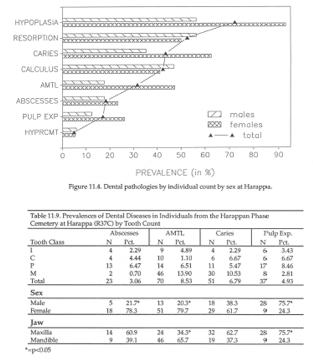A bio-archaeological examination of physiological differences among remains from Bronze Age Harappans.
"Cranial and dental metric and non-metric data derived from human skeletal remains of the Harappan phase at Harappa are employed together with comparable data from South Asia and neighboring areas to address questions of biological adaptation and continuity. A progressive decline in dental health is demonstrated to have occurred within the Indus Valley from the neolithic to the urban phase of the Harappan Civilization. This accords well with expectations of the proximate effects of increasing reliance upon agriculture. Sexual differences in dental health and differences in tooth size between humans from South Asian sites of different periods can also be related to diet and food preparation techniques. As for the question of biological continuity within the Indus Valley, two discontinuities appear to exist. The first occurs between 6000 and 4500 BCE and is reflected by the strong separation in dental non-metric characters between neolithic and chalcolithic burials at Mehrgarh. The second occurs at some point after 800 BCE but before 200 BCE. In the
intervening period, while there is dental non-metric, craniometric, and cranial non-metric evidence for a degree of internal biological continuity, statistical evaluation of cranial data reveals clear indications of interaction with the West and specifically with the Iranian Plateau."
Chapter 11 of Harappa Excavation Reports 1986-1990

